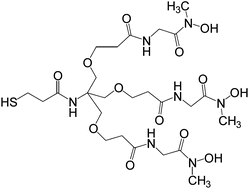“Vanishing mass” in the Sauerbrey world: quartz crystal microbalance study of self-assembled monolayers based on a tripod-branched structure with tuneable molecular flexibility†
Abstract
Complex loadings that appear on a surface with flexible spatial organisation can reveal anti-Sauerbrey behaviour due to their variable interfacial architecture even for an ultrathin monomolecular sensitive layer. The presented results demonstrate that compounds with branched and flexible structures may be organised in various spatial architectures with different viscoelastic characteristics. They act not only as a mass loading (Sauerbrey behaviour) but also as a viscous damping (anti-Sauerbrey one) of the QCM resonator at the same time. The concept is illustrated by SAM formed on a QCM silver electrode surface with a tripod-like hydroxamic thioligand (S3HX). The obtained data indicate that the interfacial layer was a combination of two S3HX surface structures – namely, the ordered α-(alpha)- and the disordered σ-(sigma)-conformation of SAM. The sigma-conformation is likely to belong to Sauerbrey-like materials with a negative frequency shift: such a system is sufficiently rigid because of multiple interactions and spatial restrictions due to the so-called “tangle of tendrils”. The alfa-conformation with a labile structure and highly ordered flexible spatial organisation is likely to be predominant in anti-Sauerbrey-like samples. Sigma- and alpha-based interfacial ensembles demonstrate different behaviour under gaseous analyte exposure. The possibility of anti-Sauerbrey-like behaviour opens the way for the formation of a unique (oppositely shifted) signal in analytical applications, especially ones that require a false-free detection of highly dangerous xenobiotics.



 Please wait while we load your content...
Please wait while we load your content...